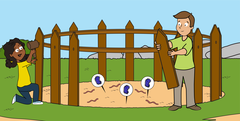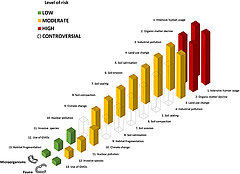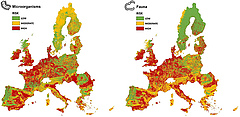Protecting soil biodiversity: a dirty job, but somebody’s gotta do it!


Figure 1: Level of risk associated with 13 potential threats to soil microorganisms and fauna. Numbers indicate the position of each threat based on scientists’ rankings, from least risky (smallest numbers) to most risky (largest numbers). Transparent bars indicate threats on which experts cannot agree, so they remain controversial and require more research. You can see that, for both microorganisms and soil fauna, the biggest risk to soil biodiversity is intensive human usage.

Figure 2: Maps of risk to soil microorganisms and fauna in 27 countries of the European Union, based on data collected from 2016. In more than half of the countries studied, 40% of the soils posed high levels of risk to soil microorganisms and soil fauna.
Open link to original article and PDF in new window.
Alberto Orgiazzi *1
1 European Commission, Joint Research Centre, Ispra, Italy
Soil biodiversity means the range of creatures, of various shapes and sizes, living in the soils—from microorganisms to animals. Soil diversity is extremely important and, to protect it, we need to know where potentially endangered soil organisms live. Unfortunately, we do not have data on the distribution of most soil species. However, we do know the potential threats to soils and soil inhabitants. Therefore, we identify areas where risks are high and try to reduce those risks, which allows us to indirectly protect soil organisms. Following this path, we mapped the risk to soil microorganisms and animals in 27 countries of the (pre-Brexit) European Union. Our results highlight the urgent need to act, as organisms living within more than 40% of soils are at high risk in most countries.
SOIL BIODIVERSITY MATTERS
An estimated one quarter of the life on our planet lives under our feet, in the soil. The vast range of organisms living in the soil is called the soil biodiversity. Organisms living in the soil provide many essential services to humankind. They support food production by helping plants to grow, and they play a key role in controlling nutrient cycles (especially carbon and nitrogen), and thus in regulating the Earth’s climate. Other less obvious but still crucial services include water purification, which makes water drinkable, and the production of substances that have important medical uses. For example, most of the antibiotics that we currently use come from soil organisms.
Despite its importance, soil biodiversity is generally not considered when people think about how to protect the Earth’s biodiversity. Most of the current plans for biodiversity protection only target organisms that live above ground. It is also not that easy to protect soil biodiversity—it is a dirty job, but one that needs to be done!
HOW TO PROTECT SOIL BIODIVERSITY
Imagine you are a superhero with a new, challenging mission: you must save a group of mammals, plants, reptiles, and insects that will disappear in a few days. If the target group lives above ground, you can easily identify where your endangered community lives. This allows you to create a protected area—maybe a kind of a fence surrounding the space where your endangered group lives. Mission accomplished: you are protecting biodiversity.
However, often the job is not that easy. If you need to safeguard organisms living below ground, you might not have much information about who they are or where they live. This is because most of the species living beneath our feet are yet to be discovered [1]. Furthermore, soil biodiversity is extremely complex and ranges from soil microorganisms, which are invisible to the naked eye, to soil fauna, including animals like earthworms and moles. Therefore, pinpointing exactly where soil organisms live is an extremely difficult, sometimes impossible task. Luckily, there is another, indirect way to protect soil biodiversity. Even if you do not know where a group of organisms lives, you can figure out the areas where soil organisms might be in danger from potential risks. Once you have mapped those high-risk areas, you can work to reduce the threats that potentially affect your target organisms. But it is not quite as easy as it sounds…
IDENTIFYING RISKS TO SOIL BIODIVERSITY
Of course, every mission faces difficulties. Indirect protection of soil biodiversity needs to overcome three main obstacles. First, we must understand the main threats to soil biodiversity. Many things can affect soil organisms, but we need to identify current threats that can be measured and that are actually known to be dangerous to life in the soil. Over the years, scientists have worked to find out what puts soil life at risk. Therefore, as a superhero, your first step should be to read all the available literature on this topic. Even though we are not superheroes, that is what we did in our study mapping at-risk soils in the European Union [2]. We identified 13 potential threats to soil organisms, from pollution and use of genetically modified organisms (GMOs) to increasing aridity (dryness) and soil loss due to extreme weather events (Figure 1).
Once we have a list of the threats to soil organisms that we want to map, our second obstacle becomes clear: soil biodiversity is immense. Are we sure that, for instance, increasing aridity has the same negative effect on all soil organisms? Increased aridity will likely be a big problem for earthworms (which love wet, moist soils), but may be less of an issue for microorganisms that can better tolerate harsh conditions. Furthermore, not all earthworm or bacterial species are affected in the same way by the same threat. In an ideal situation, we would try to create a risk map for each species of soil organism, but that would lead to millions of maps, which would be impossible even for superheroes to manage. We need a compromise. As a first step, we decided to create maps for two main groups: soil microorganisms (including bacteria and fungi) and soil fauna (including earthworms, insects, springtails, and mites [1]).
Now we have a list of threats to map and of target groups to be considered. A third obstacle emerges. To what extent does each threat affect the different groups of organisms? Aridity can cause earthworms to die, so this has a high level of risk for them. However, some bacteria can recover quickly from a dry period, so aridity poses a low level of risk to them. To assess these differences, we called on the knowledge of soil scientists who have been working on risks to soil organisms for a long time. We knew that these experts could help us by providing accurate information about the risk levels our threats pose for various species. We contacted over 100 researchers and asked them to rank our 13 threats to soil biodiversity based on the level of risk (low, moderate, high) to the soil microorganisms and fauna they studied. This information helped us to pinpoint the most accurate level of risk associated with each of the proposed threats and groups of organisms.
RISKS TO SOIL BIODIVERSITY IN THE EUROPE UNION
Now you are part of a team of superheroes; you have all you need to accomplish your mission. You have pooled all the information to identify your most dangerous enemies, combined expert opinions on groups of soil organisms, and ranked the threats to soil microorganisms and fauna (Figure 1). When we did these things, our findings suggested that, for both soil microorganisms and animals, the most dangerous threat is intensive human use of soil, which mainly means agriculture through intense physical (high cattle density, heavy machinery) and chemical (pesticides and fertilizers) inputs [3]. This is not surprising because no soil organism can do well when strange machines come to break up or destroy its home on a regular basis. At the opposite end of the scale, the use of GMOs in agriculture was ranked as being the least risky. GMOs are agricultural plants whose DNA has been modified by humans to make them grow better and produce more food [4]. The use of GMO plants in agriculture is controversial. Our findings suggested that, while the use of GMOs is not completely risk-free, other threats are more dangerous to soil biodiversity.
Scientists often disagree and, in our case, sometimes the level of disagreement was so high that it was impossible to classify the level of risk for some threats (Figure 1). For example, biodiversity experts could not agree on the effect of pollution on soil animals and the effect of climate change on soil microorganisms. These “controversial threats” were expected. An interesting side-product of our analysis has been the identification of those threats about which we still do not know enough to say how risky they are. These threats require further investigation in the future, so there is plenty of work to keep soil scientists busy!
FINDING THE ENEMIES
The next step of your mission: find out where the enemies are, by combining threat rankings with some geographical data. For instance, for the threat “use of GMOs in agriculture,” we combined a map of the European countries in which GMO cultivation is allowed (Spain, Portugal, Romania, Czechia, and Slovakia) with a map of the agricultural areas in those countries. This allowed us to identify soils where GMOs might be grown. For the threat of “intensive human usage,” we made a map showing fertilizer application (the more fertilizers used, the more intense the human usage) and number of cattle (the more cattle, the greater the impact on the soil).
Once all our geographical data were collected, thanks to supercomputers, we brought all the data together to produce maps showing the risk to soil biodiversity in the European Union (Figure 2). As we looked closely at the risk distribution in each of the 27 European countries, we found an alarming situation. In more than half of the countries studied (14 out of 27), 40% of the soils posed high levels of risk to soil microorganisms and animals. Only five countries showed that more than 40% of their soils posed low risks to soil life.
The maps we produced not only allowed us to identify the areas with higher levels of risk in each country, but they also gave us information about the activities affecting soils in those regions. All these data are fundamental to ensure the proper protection of soil biodiversity.
WHAT NEXT?
We have mapped the risks to soil biodiversity and discovered areas where help is needed to preserve soil organisms. Does this mean we can say, “Mission accomplished! Life belowground is safe!”? Not really. But here is the best part: we must now identify real-life actions that will reduce the risks to soil organisms in the high-risk areas. For instance, maybe protected areas (like national parks) can be set up to avoid, or at least reduce, human interference. However, in many cases this may not be enough. For example, extreme weather events do not have boundaries; they also occur in national parks. To reduce the impacts of severe weather on soil organisms, we need wider measures that will help to slow or reverse climate change. That is another story—a true superhero mission!
GLOSSARY
Soil biodiversity
All the living creatures that inhabit the soil.
Soil microorganisms
Organisms living in the soil that can be seen only through a microscope. Soil microorganisms include archaea, bacteria, fungi, and protists.
Soil fauna
Organisms living in the soil that belong to the kingdom Animalia. These range from tiny worms called nematodes (<0.1 mm) to larger animals like moles.
Genetically modified organism (GMO)
An organism that has had its DNA modified to give it new abilities, such as pest resistance or the ability to grow in the presence of weed-killing chemicals.
Aridity
A condition characterized by limited-to-no water availability in an environment, mainly due to scarce precipitation.
ACKNOWLEDGMENTS
The author want the thank Gráinne Mulhern for carefully proofreading the manuscrip, and to all the authors of the original publication [2]. The original source article and research were supported by the European Commission within the EcoFINDERS project (FP7-264465).
ORIGINAL SOURCE ARTICLE
Orgiazzi, A., Panagos, P., Yigini, Y., Dunbar, M. B., Gardi, C., Montanarella, L., et al. 2016. Knowledge-Based approach to estimating the magnitude and spatial patterns of potential threats to soil biodiversity. Sci. Total Environ. 545-546:11–20. doi: 10.1016/j.scitotenv.2015.12.092
REFERENCES
[1] Orgiazzi, A., Bardgett, R. D., Barrios, E., Behan-Pelletier, V., Briones, M. J. I., Chotte, J. C., et al. 2016. Global Soil Biodiversity Atlas. European Commission, Publications Office of the European Union., Luxembourg.
[2] Orgiazzi, A., Panagos, P., Yigini, Y., Dunbar, M. B., Gardi, C., Montanarella, L., et al. 2016. Knowledge-Based approach to estimating the magnitude and spatial patterns of potential threats to soil biodiversity. Sci. Total Environ. 545–546:11–20. doi: 10.1016/j.scitotenv.2015.12.092
[3] Tsiafouli, M. A., Thébault, E., Sgardelis, S. P., De Ruiter, P. C., Van Der Putten, W. H., Birkhofer, K., et al. 2015. Intensive agriculture reduces soil biodiversity across Europe. Glob. Change Biol. 21:973–85. doi: 10.1111/gcb.12752
[4] Carpenter, J. 2011. Impact of GM crops in biodiversity. GM Crops. 2:7–23. doi: 10.4161/gmcr.2.1.15086
EDITOR: Helen Phillips, Saint Mary’s University, Canada
SCIENCE MENTOR: Christopher A. Emerling
CITATION: Orgiazzi A (2022) Protecting Soil Biodiversity: A Dirty Job, but Somebody’s Gotta Do It! Front. Young Minds 10:677917. doi: 10.3389/frym.2022.677917
CONFLICT OF INTEREST: The author declares that the research was conducted in the absence of any commercial or financial relationships that could be construed as a potential conflict of interest.
COPYRIGHT © 2022 Orgiazzi. This is an open-access article distributed under the terms of the Creative Commons Attribution License (CC BY). The use, distribution or reproduction in other forums is permitted, provided the original author(s) and the copyright owner(s) are credited and that the original publication in this journal is cited, in accordance with accepted academic practice. No use, distribution or reproduction is permitted which does not comply with these terms.
YOUNG REVIEWERS
KAYSVILLE JUNIOR HIGH, AGES: 12–13
The students that reviewed this article were selected from Mr. Lanford’s Science 7 classes at Kaysville Jr High. Students that live in the area come from strong communities that also know how to appreciate and enjoy nature in the Western US. A lot of the families make a habit to go hiking, fishing, camping, rock hounding, river rafting, biking, and too many other hobbies to mention.
AUTHOR
ALBERTO ORGIAZZI
When he was a child, Alberto wanted to become a helicopter pilot. However, life is full of surprises, and instead he has gone theway of the ostrich, putting his head in the ground. Switching fromthe sky to the soil, he is nowa soil researcher at the European Commission’s Joint Research Center. His current mission focuses on the creation of detailed maps of life in European soils. *alberto.orgiazzi@gmail.com
